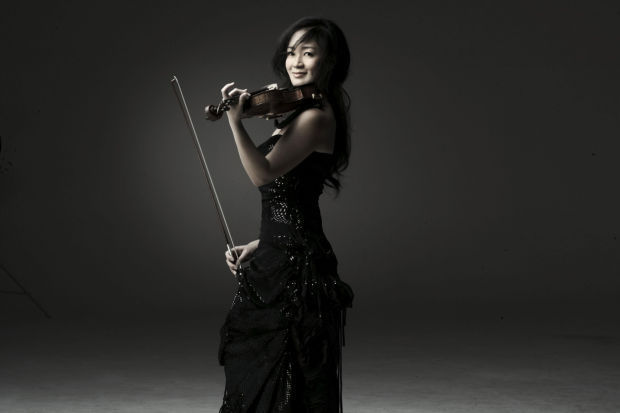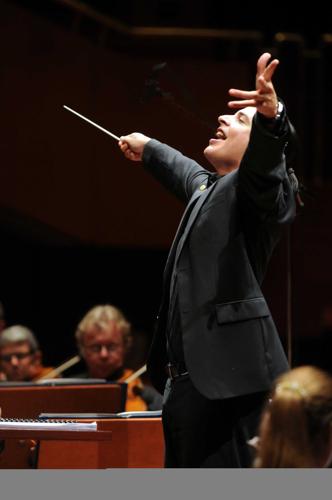The audience at Friday night’s Tucson Symphony Orchestra concert was giving José Luis Gomez his well-deserved standing ovation at the end of the night when something interesting happened.
A foot-stomping chorus broke out from the orchestra as Gomez returned to the Tucson Music Hall stage for one final bow. He gently touched the shoulder of TSO Concertmaster Lauren Roth, urging her to stand up. But Roth sat still and she and her colleagues stomped a bit louder.
It was their ovation for a guest conductor who brought out some remarkable playing from this group in works that challenged their mettle and imaginations.
Gomez was the surprise hit of the evening, which was no easy task when sharing the stage with the stunning violin soloist Chee-Yun. She herself was nothing short of breathtaking in her solo turn at Tchaikovsky’s technically challenging Violin Concerto in D major. Her pristine 1669 Francesco Ruggieri violin, reportedly buried with its owner and re-emerging in 1991 with no scratches or wear and tear to hint at its antiquity, produced the lushest, most gorgeous sound. There were no wolfs, as she called them, little hiccups and distortions that can muddy the works especially on a piece that demands so much of the musician.
Tchaikovsky penned a lot of notes in his Violin Concerto, and Chee-Yun and her Ruggieri let us hear each one on its own.
Then she treated the audience of 1,200 to an encore of Fritz Kreisler's beautiful Recitativo and Scherzo, which Kreisler, a violinist of renown in his day, composed for his friend Eugene Yszÿa.
The audience sat in near complete silence — not a single muffled coughs or seat shifting creak could be heard — while she played. It was as if time had stood still for those few minutes and everyone was experiencing the same moment.
After the intermission, the focus was on Gomez, who is in contention to replace George Hanson as the TSO’s music director. The Venezuelan-born Spanish conductor made his big international splash with a unanimous win at the 2010 International Sir Georg Solti Conductor’s Competition in Frankfurt, Germany. Since then he has been an in-demand guest conductor, with stints around the globe including guest spots with orchestras and conducting Mozart’s “Le Nozze di Fagaro” in Italy, Rossini’s “La Cenerentola” at Stuttgart Opera and Puccini’s “La Boheme” with Frankfurt Opera.
And on Friday night and again Sunday, he is in Tucson.
Gomez is a musician’s musician, a conductor possessed with abundant talent and the ability to convey his vision with subtle fluidity. Small gestures led to giant musical statements in Carl Nielsen’s Symphony No. 2 “The Four Temperments.” He drew down the third movement to a near whisper then silenced the orchestra with a flick of the wrist; everyone on stage froze and remained that way, bows raised to the strings, motionless, for several seconds before resuming the final thrilling movement.
It was the first time the orchestra played Nielsen’s symphony. They also had never played Grieg’s “Norwegian Dances,” the concert’s opening piece that Gomez executed as alternately lush and cinematic and crashingly playful.
Gomez brought out in the orchestra a freshness and vibrancy that sometimes gets lost in the day-to-day of performing. His conducting was measured and taut, yet fluid and flexible, as if the orchestra and conductor were performing as an extension of one another. And for us in the audience, that was pretty thrilling.





